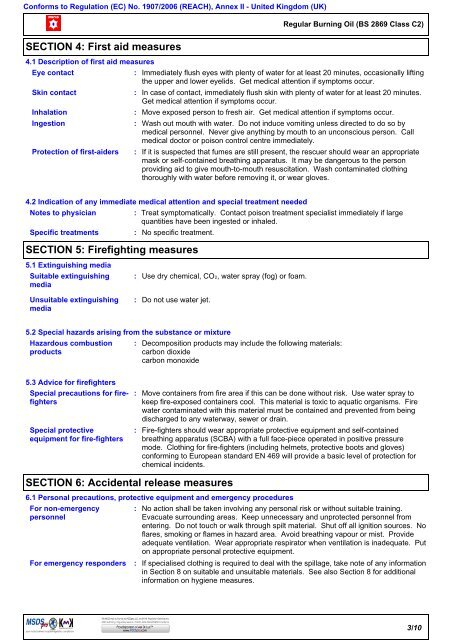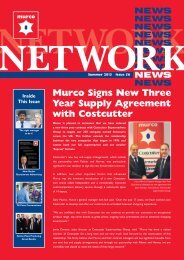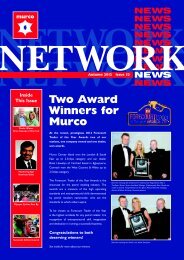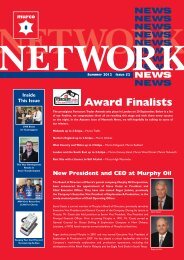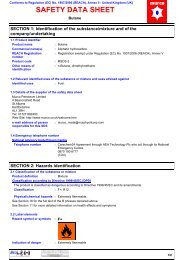Low Sulphur Regular Burning Oil â BS 2869 ... - Murco Petroleum
Low Sulphur Regular Burning Oil â BS 2869 ... - Murco Petroleum
Low Sulphur Regular Burning Oil â BS 2869 ... - Murco Petroleum
You also want an ePaper? Increase the reach of your titles
YUMPU automatically turns print PDFs into web optimized ePapers that Google loves.
Conforms to Regulation (EC) No. 1907/2006 (REACH), Annex II - United Kingdom (UK)<br />
<strong>Regular</strong> <strong>Burning</strong> <strong>Oil</strong> (<strong>BS</strong> <strong>2869</strong> Class C2)<br />
SECTION 4: First aid measures<br />
4.1 Description of first aid measures<br />
Eye contact<br />
Skin contact<br />
Inhalation<br />
Ingestion<br />
Protection of first-aiders :<br />
:<br />
:<br />
:<br />
:<br />
Immediately flush eyes with plenty of water for at least 20 minutes, occasionally lifting<br />
the upper and lower eyelids. Get medical attention if symptoms occur.<br />
In case of contact, immediately flush skin with plenty of water for at least 20 minutes.<br />
Get medical attention if symptoms occur.<br />
Move exposed person to fresh air. Get medical attention if symptoms occur.<br />
Wash out mouth with water. Do not induce vomiting unless directed to do so by<br />
medical personnel. Never give anything by mouth to an unconscious person. Call<br />
medical doctor or poison control centre immediately.<br />
If it is suspected that fumes are still present, the rescuer should wear an appropriate<br />
mask or self-contained breathing apparatus. It may be dangerous to the person<br />
providing aid to give mouth-to-mouth resuscitation. Wash contaminated clothing<br />
thoroughly with water before removing it, or wear gloves.<br />
4.2 Indication of any immediate medical attention and special treatment needed<br />
Notes to physician<br />
Specific treatments<br />
:<br />
:<br />
Treat symptomatically. Contact poison treatment specialist immediately if large<br />
quantities have been ingested or inhaled.<br />
No specific treatment.<br />
SECTION 5: Firefighting measures<br />
5.1 Extinguishing media<br />
Suitable extinguishing<br />
media<br />
Unsuitable extinguishing<br />
media<br />
:<br />
:<br />
Use dry chemical, CO2, water spray (fog) or foam.<br />
Do not use water jet.<br />
5.2 Special hazards arising from the substance or mixture<br />
Hazardous combustion<br />
products<br />
:<br />
Decomposition products may include the following materials:<br />
carbon dioxide<br />
carbon monoxide<br />
5.3 Advice for firefighters<br />
Special precautions for firefighters<br />
Special protective<br />
equipment for fire-fighters<br />
:<br />
:<br />
Move containers from fire area if this can be done without risk. Use water spray to<br />
keep fire-exposed containers cool. This material is toxic to aquatic organisms. Fire<br />
water contaminated with this material must be contained and prevented from being<br />
discharged to any waterway, sewer or drain.<br />
Fire-fighters should wear appropriate protective equipment and self-contained<br />
breathing apparatus (SCBA) with a full face-piece operated in positive pressure<br />
mode. Clothing for fire-fighters (including helmets, protective boots and gloves)<br />
conforming to European standard EN 469 will provide a basic level of protection for<br />
chemical incidents.<br />
SECTION 6: Accidental release measures<br />
6.1 Personal precautions, protective equipment and emergency procedures<br />
For non-emergency<br />
personnel<br />
For emergency responders :<br />
:<br />
No action shall be taken involving any personal risk or without suitable training.<br />
Evacuate surrounding areas. Keep unnecessary and unprotected personnel from<br />
entering. Do not touch or walk through spilt material. Shut off all ignition sources. No<br />
flares, smoking or flames in hazard area. Avoid breathing vapour or mist. Provide<br />
adequate ventilation. Wear appropriate respirator when ventilation is inadequate. Put<br />
on appropriate personal protective equipment.<br />
If specialised clothing is required to deal with the spillage, take note of any information<br />
in Section 8 on suitable and unsuitable materials. See also Section 8 for additional<br />
information on hygiene measures.<br />
3/10


